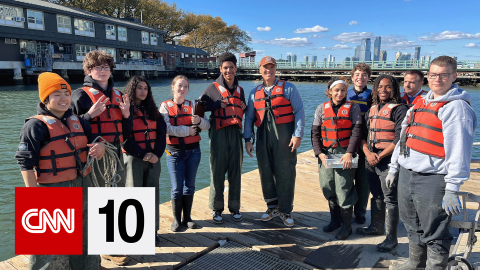Today's Show Transcript
COY WIRE, CNN 10 ANCHOR: What's up, sunshine? Hope you're having a terrific Tuesday. I'm Coy Wire with your 10 minutes of news.
Now, today's election day in some states. There are big races for governor in Virginia, a lot of people paying close attention to the mayor's race in New York City. Those of you who have a virtual learning day, thank you for joining us and watching from home.
All right, let's get you your news. We begin in Afghanistan, where a massive search and rescue operation is underway following a deadly earthquake in the country's northern region. The powerful 6.3 magnitude quake hit early Monday morning near Mazar-i-Sharif, one of the most populated cities in that part of the country. As of this taping, government officials say at least 20 people have been killed and hundreds more have been injured. But they expect those numbers to rise as recovery efforts continue.
The powerful quake was felt in three neighboring countries and briefly closed a key passageway outside the capital of Kabul. It also damaged the iconic Blue Mosque, one of Afghanistan's architectural treasures and a holy site of annual pilgrimage.
Afghanistan has endured a series of catastrophic earthquakes in recent years. Just over two months ago, a 6.0 magnitude quake killed more than 2,200 people in the country's eastern region.
Afghanistan lies at the collision boundary of two huge tectonic plates, the Indian plate, which moves northward, and the Eurasian plate, which has been mostly stable.
Pop quiz, hot shot. The Adriatic Sea is known for its unusually high, what, compared to most seas?
Salinity or salt content, clarity, tides or depth.
If you said clarity, clearly you know your stuff. Unlike most seas, which are bordered by muddy river deltas, much of the Adriatic coastline is rocky and limestone based. This means less soil erosion and sediment runoff, so the water stays clear.
The Adriatic Sea is home to one of the world's most diverse populations of aquatic wildlife. The picturesque sea, which lies between Italy and the Balkans in Eastern Europe, is home to more than 7,000 native species. But overfishing, pollution and habitat loss are putting some of its most unique species of sharks and rays at risk.
Let's learn about a research group that's trying to change that in today's Call to Earth. They're using cutting-edge technology to help save the unique deep-sea dwellers in the Adriatic Sea.
(BEGIN VIDEOTAPE)
ZAIN ASHER, CNN CORRESPONDENT (voice-over): It's pitch black and choppy beneath the Adriatic Sea at night, with only the moon above and a flashlight below to guide the way.
But these are ideal diving conditions for Bosnian marine biologist Andrej Gajic, who searches for sharks who come to life after dark.
ANDREJ GAJIC, MARINE BIOLOGIST, SHARKLAB ADRIA: I think the biggest misconception is these are some kind of menacing, bloodthirsty machines. The majority of the species grow less than a meter, they are small. They are terrified of humans.
The more time I spend diving, I actually realize how fragile they are. My team and I decided to come here to conduct systematic research about the number of individuals, diversity of the species and their key habitats in this area before it's too late.
ASHER: Andrej runs Sharklab Adria, a research group in Albania working to protect some of the Mediterranean's most vulnerable marine life from documenting rare sharks to investigating causes of disease and death.
GAJIC: The majority of my career are dedicated studying the deep sea and the angular roughshark that is particularly important for me.
Diving with the roughsharks it's like I meet some dinosaur from Jurassic or whatever. It's a critically endangered species we try to protect like for the past ten years, as well as the spiny butterfly rays.
Our team has rediscovered the population after no records in this century in the region.
ASHER: His team spends about 160 days in the field each year assessing marine animal health, behavior, environmental exposure and more.
GAJIC: We are now trying to understand the population better, the threats and what we can do to mitigate. The fisheries is definitely one of the worst. There's also pollution, there's habitat loss. Climate change is a terrible issue.
ASHER: After his night dive concludes at 2:00 a.m., Andrej is swapping his scuba gear for his lab scrubs. He will work through the night with his team, analyzing bycatch donated by a local fishery just hours earlier.
GAJIC: This is the small, juvenile.
We process a large amount of samples, unfortunately, that are always retrieved dead by the trawlers. Without their support, we won't be able to actually do this scientific research.
ASHER: Sharklab Adria also runs an on-site rehabilitation program where marine life are cared for and monitored before being released back into the wild.
GAJIC: We have a lot of sharks, skates and rays coming to rehabilitation after being landed or retrieved alive, and most commonly, we work with severe traumatic fractures caused by the poor handling and the hooking.
ASHER: Alongside his research, Andrej works aboard commercial trawlers collecting data on bycatch and teaching fishermen how to safely return live animals to the sea.
GAJIC: Being on the trawlers is very eye-opening moment. You see the reality and this is why I tend to call our work being at the front line of conservation.
I think over the past few decades, we somehow split from the nature. And I think this is the right time to take the responsibility for what we are doing to our home.
(END VIDEOTAPE)
WIRE: Call to Earth Day 2025 is this Thursday, November 6th, where we are embracing the theme, "Guard Your Green Space." And urging individuals like yourselves, communities, nations to take bold collective action to protect the natural world that sustains us.
Sign up at CNN.com/CallToEarthDay and share how you are guarding your green space.
Have some sports news for you today. I had a chance to catch up with the newly crowned NASCAR Cup Series champ, Kyle Larson, who just won the season finale over the weekend in Phoenix. He's used to driving really fast, right?
So, I had some really fast rapid-fire questions for the now two-time Cup Series champ.
(BEGIN VIDEOTAPE)
KYLE LARSON, 2025 NASCAR CUP SERIES CHAMPION: Hey, I'm two-time NASCAR Cup Series champion Kyle Larson and you're watching CNN 10.
WIRE: What's it like driving around off the track? Is it torture to drive the speed limit as a NASCAR champion?
LARSON: It's not. That's a very frequent question that we get as drivers. And to me, a lot of times the interstate can feel just as fast as the track because you'll have people going at a lot, you know, different speeds. So, that's where a lot of the sensation comes from too.
WIRE: Is it weird making right-hand turns?
LARSON: No, no, but I will definitely clip my fair share of curbs on right-handers.
WIRE: So, you are a mere mortal, just like all of us drivers. How do you feel about the driverless cars we're seeing pop up everywhere?
LARSON: Yeah, so the only place I really ever see it is when I'm here in Scottsdale and I've yet to be in one, but I want to try it out.
WIRE: So, you'd be totally fine and open to like hopping in a Waymo and relinquishing your control of the vehicle?
LARSON: As I've been in Arizona here, I've not seen one, you know, stacked up in a telephone pole. So, I think I could trust it.
WIRE: Finally, all you've been through, all you've overcome, all you're doing, what's some advice you would give your younger self and all the next generation out there? What would you say to them?
LARSON: I don't know. I think just continue to always, you know, treat people with respect and have fun, you know, have fun with what you're doing.
WIRE: That's awesome, man.
(END VIDEOTAPE)
WIRE: Today's story, getting a 10 out of 10, someone overcoming adversity to achieve an historic feat. Shannon Britt was born with a rare eye cancer that left her legally blind, but she's now preparing to represent Team USA in the first ever Women's Blind Cricket World Cup.
(BEGIN VIDEO CLIP)
SHANNON BRITT, BLIND CRICKET TEAM MEMBER: I didn't think I was going to make the team. I was just going to try something new and I wound up being decent at it. So, let's go USA.
(END VIDEO CLIP)
WIRE: Shannon does it all, batting, bowling, and fielding using a special ball that rattles like a maraca, allowing her to track it with her ears. And get this, since the rest of her team is totally blind, she wears special goggles to completely black out her vision. Shannon said she never expected to become an international sports star, but mom, oh, mom isn't surprised at all.
DONNA BRITT, SHANNON'S MOM: She's done a lot of amazing things in her life and this is cherry on top.
(END VIDEO CLIP)
WIRE: Shannon and her team will head to India and Sri Lanka to battle a host of other nations for the world title. That is wickedly impressive.
All right, superstars, today's shout outs are going to some of you who decided to play Coy this Halloween. They say imitation is the sincerest form of flattery, so consider me flattered. Nathan Chung and Mr. Layman's class at Palo Verde Middle School in Phoenix, Arizona, I just want to be vesties with you. Rise up.
And allow me to introduce you to Ms. Lauren Ledford at Brookwood Christian School in Ackworth, Georgia.
(BEGIN VIDEO CLIP)
UNIDENTIFIED FEMALE: Welcome back to CNN 10, your daily 10 minutes of news.
(END VIDEO CLIP)
WIRE: You are absolutely coiffed. Please don't come for my job though.
Tomorrow is Your Word Wednesday, so don't forget to submit a vocabulary word and send it to me or our CNN 10 Instagram page, and we will work it into tomorrow's show.
Remember, you are more powerful than you know, so go out there and make someone smile today. Make their day.
I'm Coy Wire. We are CNN 10.
END
CNN 10's Weekly News Quiz

 • Video 10:29Video CNN10 A secret tunnel beneath the heart of Rome 10:29
• Video 10:29Video CNN10 A secret tunnel beneath the heart of Rome 10:29 • Video 10:36Video CNN10 The centuries-old fashion inspiring Halloween's hottest costumes 10:36
• Video 10:36Video CNN10 The centuries-old fashion inspiring Halloween's hottest costumes 10:36 • Video 11:06Video CNN10 The high school connecting students with the sea 11:06
• Video 11:06Video CNN10 The high school connecting students with the sea 11:06 • Video 10:04Video CNN10 Hurricane Melissa makes landfall as "storm of the century" 10:04
• Video 10:04Video CNN10 Hurricane Melissa makes landfall as "storm of the century" 10:04 • Video 10:27Video CNN10 The truth behind your clothing’s ‘made in Guatemala’ label 10:27
• Video 10:27Video CNN10 The truth behind your clothing’s ‘made in Guatemala’ label 10:27 • Video 10:35Video CNN10 The invasive species threatening Lake Erie's shipwrecks 10:35
• Video 10:35Video CNN10 The invasive species threatening Lake Erie's shipwrecks 10:35 • Video 10:34Video CNN10 A ballet legend takes her final bow 10:34
• Video 10:34Video CNN10 A ballet legend takes her final bow 10:34 • Video 10:21Video CNN10 How a groundbreaking study led to an allergy breakthrough 10:21
• Video 10:21Video CNN10 How a groundbreaking study led to an allergy breakthrough 10:21





